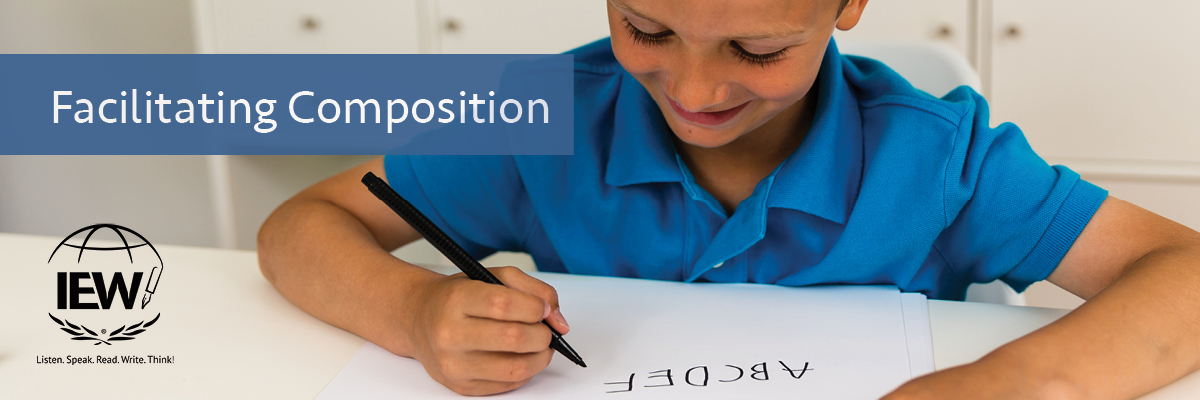
Parts 1, 2, and 3 of this series described the tremendous influence of Anna Ingham’s Blended Sound-Sight Program of Learning in the development of IEW’s Classroom Supplement and Lesson Plans for K–2. In this final segment we focus on handwriting and the role copywork plays in preparing children in the primary grades for written composition. In this final segment we’ll focus on handwriting and the role copywork plays in preparing children in primary grades for written composition.
Mrs. Ingham considered the ability to print effortlessly foundational to composition. She believed that “with an early start and consistent practice, printing will become so automatic that it will allow free flow of ideas as written communication is blooming” (51). Specifically, this type of handwriting instruction benefits the young child in several areas:
- It develops visual and fine-motor skills.
- It teaches correct letter formation.
- It teaches consistent letter recognition.
- It teaches sound-symbol connection.
- It teaches spoken and written word connection.
- It provides a positive learning experience.
Just as in our K–2 poetry, grammar, and phonics lessons, Anna Ingham’s time-tested, practical approach and her deep understanding of how young children do not simply learn but blossom are models for IEW’s approach to handwriting instruction. Printing is taught as a separate subject in kindergarten and the beginning of first grade before it is integrated into writing from then on. Let’s take a closer look at the features of IEW’s handwriting lessons for primary grades.
Letter stories add context and connection.
 Kindergarten printing lessons use letter stories to teach the sound and formation of each letter. Following the process Mrs. Ingham used in her own classroom, instruction focuses on the sound each letter makes, not its name. For example, the letter c is introduced as the happy letter. It is happy because it is a cookie that someone took a bite out of. The teacher models the hard sound of c, not the name of the letter (|c|, |c|, cookie). On the other hand, the letter o is the sad letter. “Ah,” says the o, “nobody took a bite out of me.” The letter stories and the teacher’s expressive enthusiasm as she introduces each letter provide a powerful connection that makes remembering each letter’s sound and how to form it correctly stick.
Kindergarten printing lessons use letter stories to teach the sound and formation of each letter. Following the process Mrs. Ingham used in her own classroom, instruction focuses on the sound each letter makes, not its name. For example, the letter c is introduced as the happy letter. It is happy because it is a cookie that someone took a bite out of. The teacher models the hard sound of c, not the name of the letter (|c|, |c|, cookie). On the other hand, the letter o is the sad letter. “Ah,” says the o, “nobody took a bite out of me.” The letter stories and the teacher’s expressive enthusiasm as she introduces each letter provide a powerful connection that makes remembering each letter’s sound and how to form it correctly stick.
Jackie Hammond, a veteran teacher in the Bourbonnais Elementary School District 53 (Illinois) discovered that the letter stories helped her students in kindergarten connect with the letters and motivated them to practice:
 The stories gave learning the strokes context and meaning, which definitely helped create consistent practice. They provided the emotional tie that children need to willingly tackle the discipline required. The Classroom Cards and individual game cards are effective reminders because they help the students by visually connecting the story, the stroke, and the printed letter.
The stories gave learning the strokes context and meaning, which definitely helped create consistent practice. They provided the emotional tie that children need to willingly tackle the discipline required. The Classroom Cards and individual game cards are effective reminders because they help the students by visually connecting the story, the stroke, and the printed letter.
Letters are taught in stroke order.
Rather than teaching the letters in alphabetical order, the lowercase letters are presented in groups according to their starting stroke. Introducing the letters this way makes learning them easier because the children learn a few strokes at a time that work with many letters. Doing so provides opportunities for repeated practice of the strokes before moving on to new ones, which improves muscle memory. This order is demonstrated in Printing with Letter Stories.

By reminding pupils of the stroke order and the height of the letters as they are presented (tall letters and short letters), teachers ensure that their students will be more successful as they learn to print. The lowercase letters are introduced and practiced in the kindergarten lessons in Weeks 1–10. Capitals are also introduced but not practiced until Week 11. Grades 1 and 2 review letter formation at the beginning of the year.
Print size transitions gradually.
Too often, schools force young children to write on guidelines before they are physically ready and then remove guidelines too soon. IEW’s student materials were designed to help children transition from large to small print size in graduated steps.
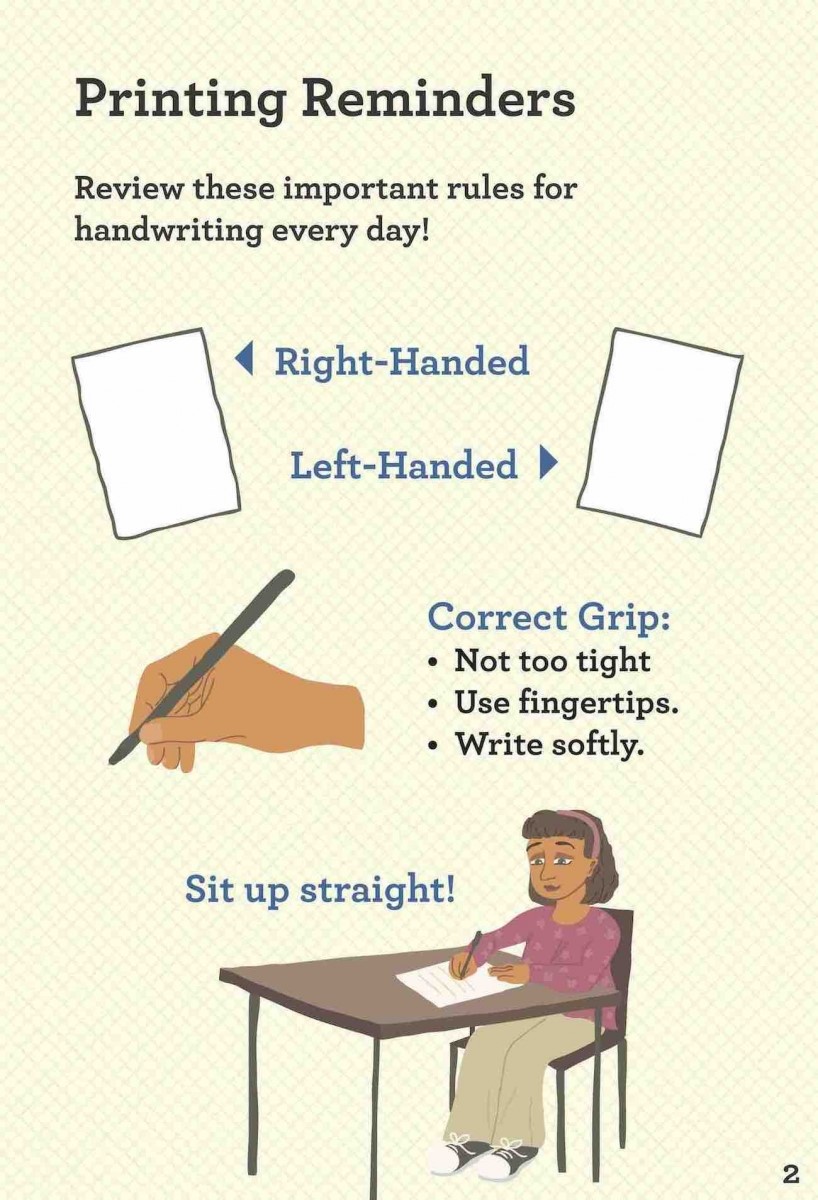 Step 1: Students print in letter boxes.
Step 1: Students print in letter boxes.
Letter blocks are used on the student handouts in Weeks 1‒10 in kindergarten and 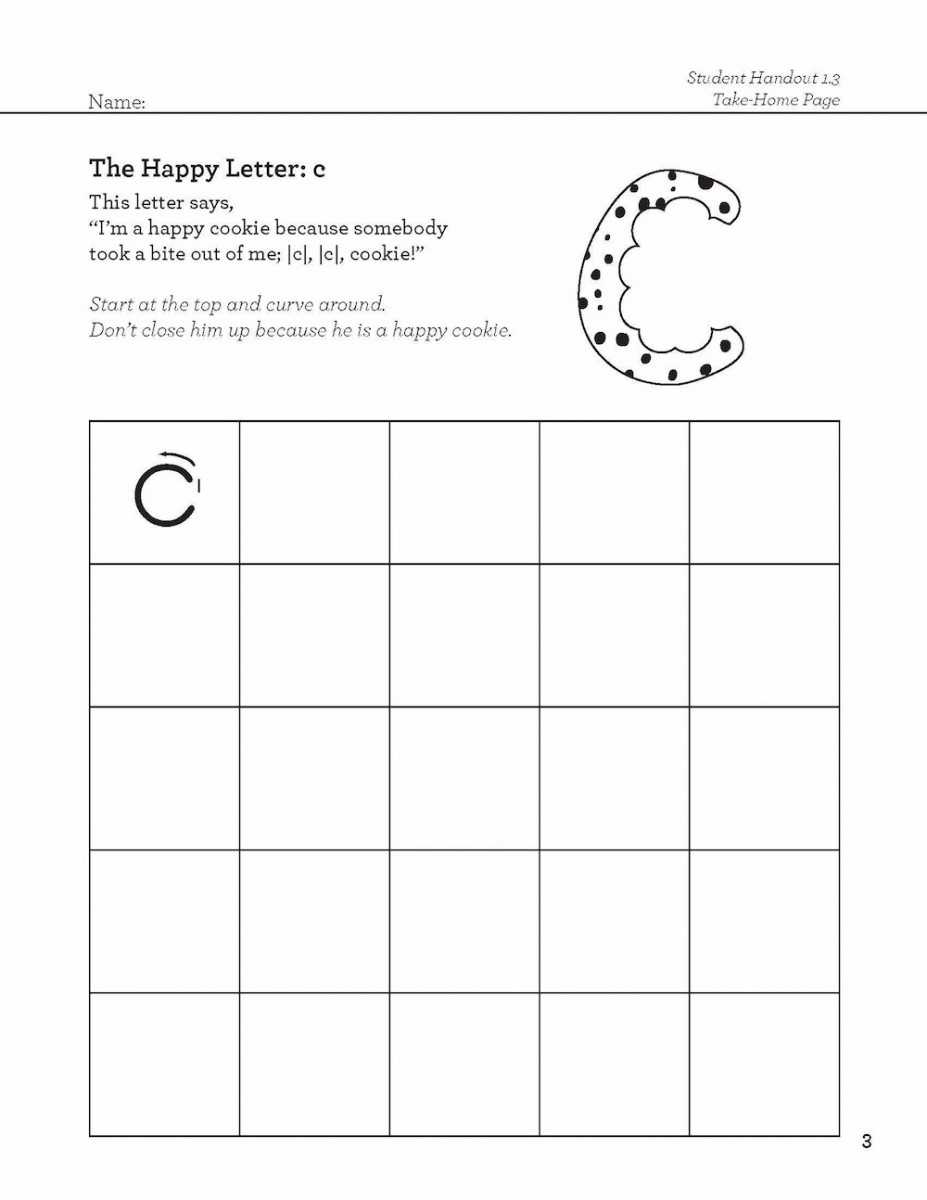 Weeks 1‒3 in grade 1. Students practice printing one letter in each box, which allows them to focus on forming the letter itself without having to worry about lines. IEW has also created large, colorful classroom Primary Posters that include a Printing Reminders poster and an Alphabet poster. Click on the links to see samples of the kindergarten, grade 1, and grade 2 posters.
Weeks 1‒3 in grade 1. Students practice printing one letter in each box, which allows them to focus on forming the letter itself without having to worry about lines. IEW has also created large, colorful classroom Primary Posters that include a Printing Reminders poster and an Alphabet poster. Click on the links to see samples of the kindergarten, grade 1, and grade 2 posters.
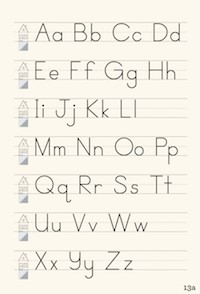 Step 2: Students print on paper with guidelines.
Step 2: Students print on paper with guidelines.
The transition from boxes to guidelines begins in Week 11 in kindergarten and  Week 4 in grade 1. The Alphabet poster displays the entire alphabet on the guidelines, using an image of a house on each line to show where each letter “lives.” Most lowercase letters live on the main floor. Some are so tall that their heads poke up into the attic. Others have parts that sink down into the basement. Teachers demonstrate that the letters bump their heads on the ceiling and sit on the floor. During this phase, all student handouts have a superimposed house on the guidelines, providing a visual cue to help them form each letter correctly.
Week 4 in grade 1. The Alphabet poster displays the entire alphabet on the guidelines, using an image of a house on each line to show where each letter “lives.” Most lowercase letters live on the main floor. Some are so tall that their heads poke up into the attic. Others have parts that sink down into the basement. Teachers demonstrate that the letters bump their heads on the ceiling and sit on the floor. During this phase, all student handouts have a superimposed house on the guidelines, providing a visual cue to help them form each letter correctly.
As students advance from kindergrten to first grade to second grade, the size of the guidelines transitions as well. Half-inch guidelines are used on student handouts in kindergarten for the remainder of the year. In grade 1, half-inch guidelines are used until Week 12, when they narrow slightly to one-quarter inch—the same height as standard wide-ruled paper. Students in grade 2 practice on one-quarter inch guidelines all year.
Experience has shown that students who use guidelines for a number of years develop much 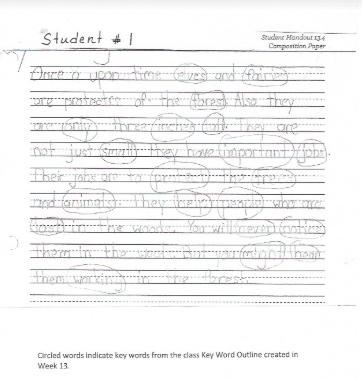 better handwriting than those who switch too early to conventional lined paper without guidelines. In fact, IEW recommends the use of guidelines well into the elementary years. IEW’s Cursive Knowledge Student Book features practice pages that start with one-half inch guidelines as students learn each letter and then transition to one-quarter inch guidelines for copywork practice.
better handwriting than those who switch too early to conventional lined paper without guidelines. In fact, IEW recommends the use of guidelines well into the elementary years. IEW’s Cursive Knowledge Student Book features practice pages that start with one-half inch guidelines as students learn each letter and then transition to one-quarter inch guidelines for copywork practice.
Click on each grade level to see sample student handout pages for kindergarten, grade 1, grade 2, and the Cursive Knowledge Student Book.
Jackie Hammond was impressed by the difference in her students’ printing during her first year using IEW in her classroom.
In all the years I have taught kindergarten, I have never seen such beautiful handwriting, consistent letter formation, proper mechanics, and detailed student illustrations.
The student handwriting sample on the right is a Week 13 paragraph written by a first grade English Learner at Peck Elementary School in Chicago. The circled words are the key words from the key word outline created by the class.
Copywork develops visual tracking.
Being able to track text is necessary for writing as well as reading. It involves hand-eye coordination and an understanding of left-to-right directionality. The printing lessons in grades K‒2 are designed to gradually develop the primary student’s ability to track text as they write. This is done intentionally in three stages:
- Students copy from models on the same handout. The letters, words, sentences, or paragraphs to be copied are modeled on the student handout pages. Students copy them directly below the model.
- Students copy from paper to paper. The models to be copied or the source texts used to create a key word outline are on a separate handout. Students copy from the source handout to the copywork handout.
- Students copy from the board to paper. The teacher writes the outline, sentence, or paragraph created together as a class on the board. Students copy it onto their handout paper.
Why copywork? When students copy sentences correctly, they are imitating correct capitalization, punctuation, and spacing between letters and words as well as imitating the correct formation of letters and syntax. Teachers not only report that the modeling and consistency provide copywork results with much less frustration in children as they write, but teachers also observe fewer letter reversals and random capitals placed in the middle of words. For more information about the benefits of copywork, listen to IEW Podcast Episode 206: The Four Language Arts Part 4: Writing.
Pacing through the copywork stages varies for each grade level. Kindergartners spend most of the year copying from models on the same page. In contrast, second graders copy from the board and eventually may be ready to work more independently beginning in Week 3. First graders fall somewhere in between. Teachers should be aware that for some students the ability to track may not match the pacing in the Classroom Supplement for their grade level. If you see your students struggling to copy from the board, it could mean that their eye muscles may not be fully developed yet. If so, shorten the distance between the student and the writing to be copied by providing them a paper copy of what is on the board and encourage them to copy as much as they can. There are reminders in the lesson instructions to do this.
Regrettably, there are far too many people who believe that teaching children to write legibly—particularly in cursive script— is a relic of the past. What they fail to realize is that being able to handwrite effortlessly allows ideas to flow more easily from the child’s brain to the page. In fact, research has found that a connection exists between writing by hand and reading, writing by hand and retaining information, and even writing by hand and idea generation.
IEW’s commitment to methods that recognize and reflect child brain development has resulted in K–2 lessons that are engaging to young children while giving them a head start in their journey to becoming confident and competent communicators and thinkers. A first grade teacher in the Berwyn North School District 98 (Illinois) shared this testimony with us:
Teaching writing to six-year-olds has always felt like an uphill battle. However, since integrating IEW into our English Language Arts instruction, we have seen systematic growth in our students’ abilities. The IEW program uses a systematic, thoughtful, and structured approach that engages the whole learner. They are reading through the lens of writers, carefully dissecting the instructional poems and pieces of writing. In turn, they become writers who can take the tools they have learned and purposefully use their voices to communicate through their writing. IEW gives teachers a clear and defined starting point, gives students a focus, and makes writing accessible to all learners. I would absolutely encourage teachers of any level to try it, stick with it, and watch your students grow!
We hope that this four-part series has illustrated the benefits of using IEW’s K–2 methods and materials to provide the foundations of literacy necessary to nurture young writers.
Contact your IEW Educational Consultant to learn more about our instructional materials for primary students. E-mail schools@IEW.com or call 800.856.5815 for more information.
Here are links to other blog posts in this series:
Foundation 1: Language Development through Poetry
Foundation 2: Building Grammar Skills with Poetry
Foundation 3: Teaching Phonics through Poetry
Work Cited
Ingham, Anna Gertrude. The Blended Sound-Sight Program of Learning. Sixth ed.,
Nisku Printers, 2004.
IEW® and Structure and Style® are registered trademarks of the Institute for Excellence in Writing, L.L.C.
|
Jean brings 34 years of classroom experience to IEW, having taught grades 1–6 in New York, Virginia, and in California, where she taught sixth-grade language arts in the Rocklin Unified School District. She was introduced to IEW in 2001 when a colleague shared Student Writing Intensive videos at weekly school staff meetings. As a result of student progress and teacher enthusiasm at her school, RUSD brought Andrew Pudewa to Rocklin many times over the next several years to train district teachers, resulting in improved student writing and test scores district-wide. Named Rocklin’s “Elementary Teacher of the Year” in 2001, Jean was also included in the 2004 and 2005 editions of Who’s Who Among America’s Teachers. |

